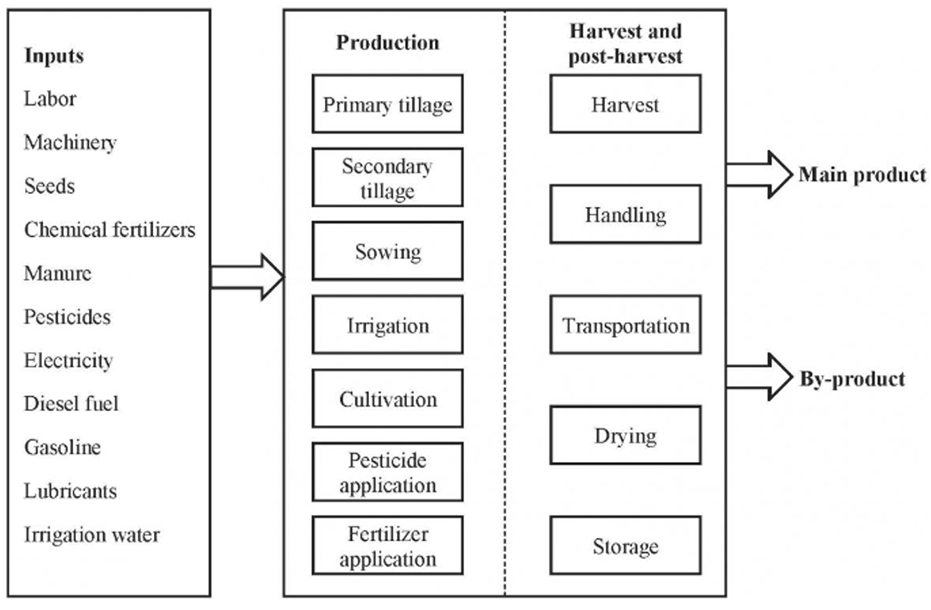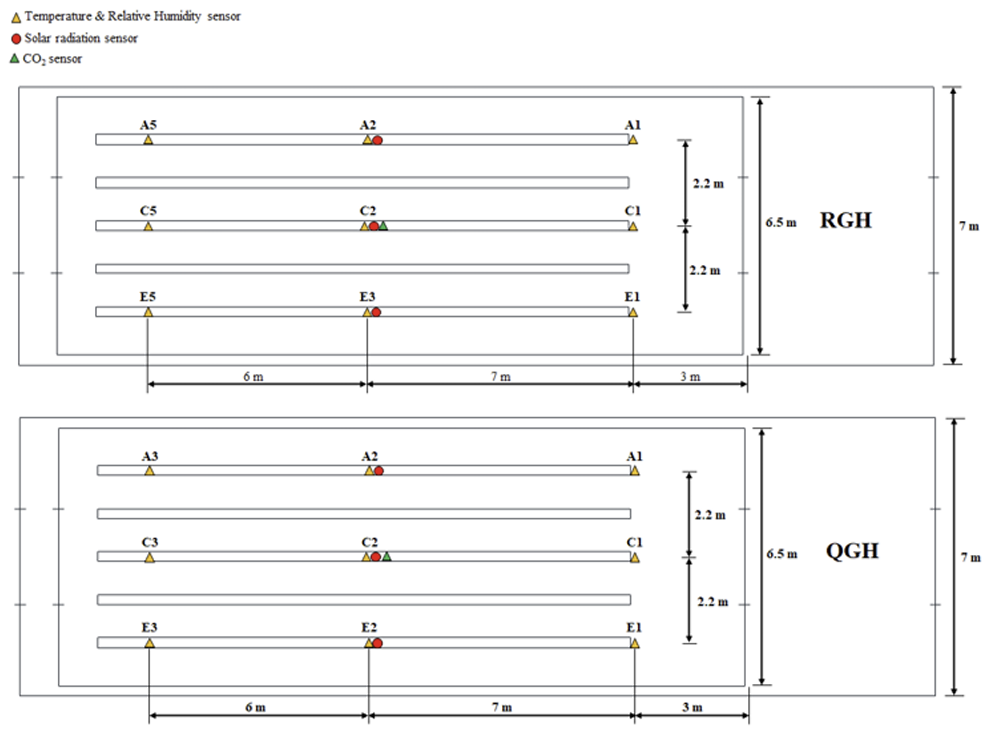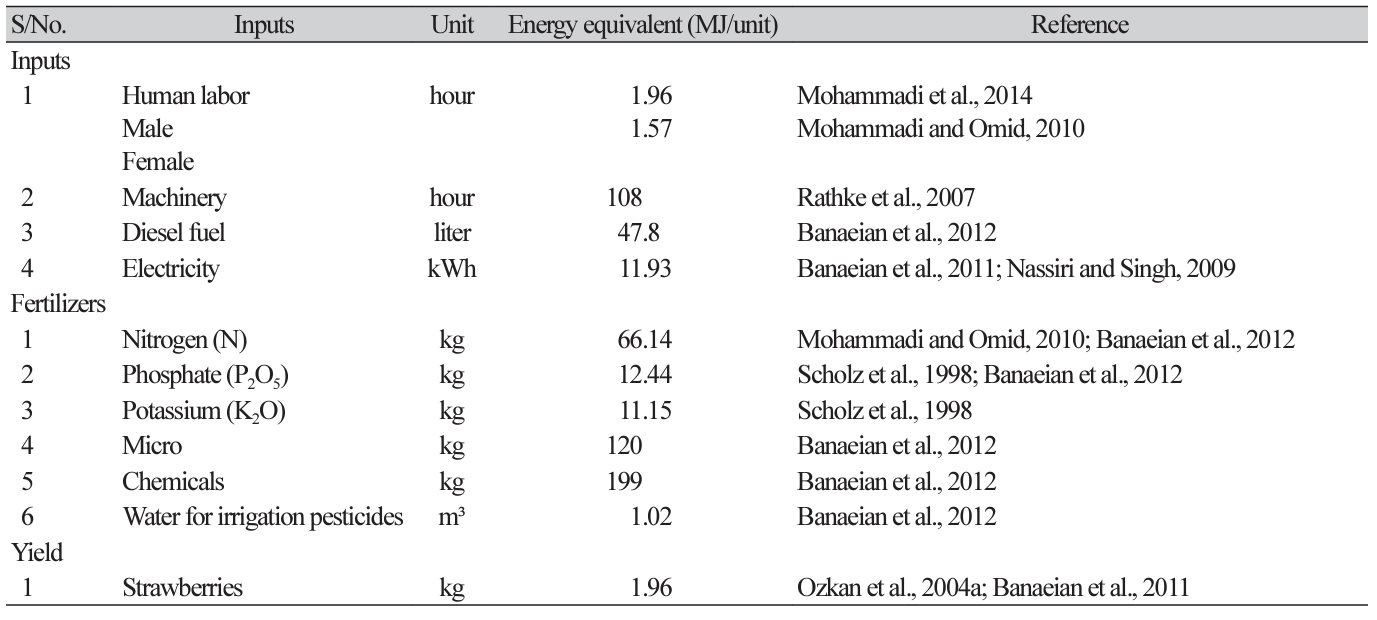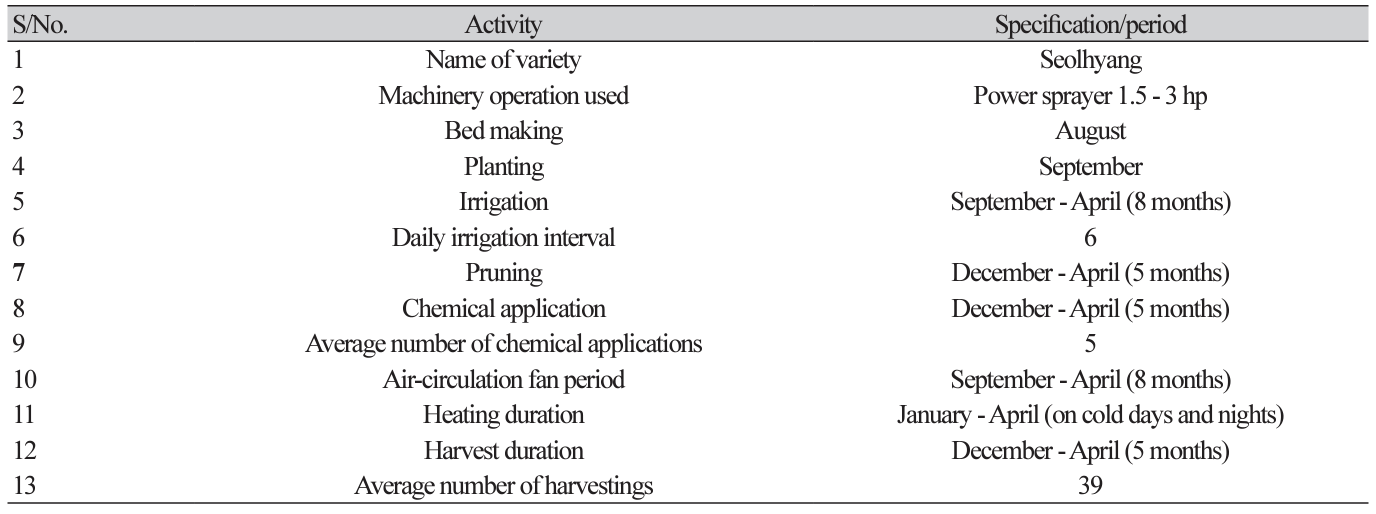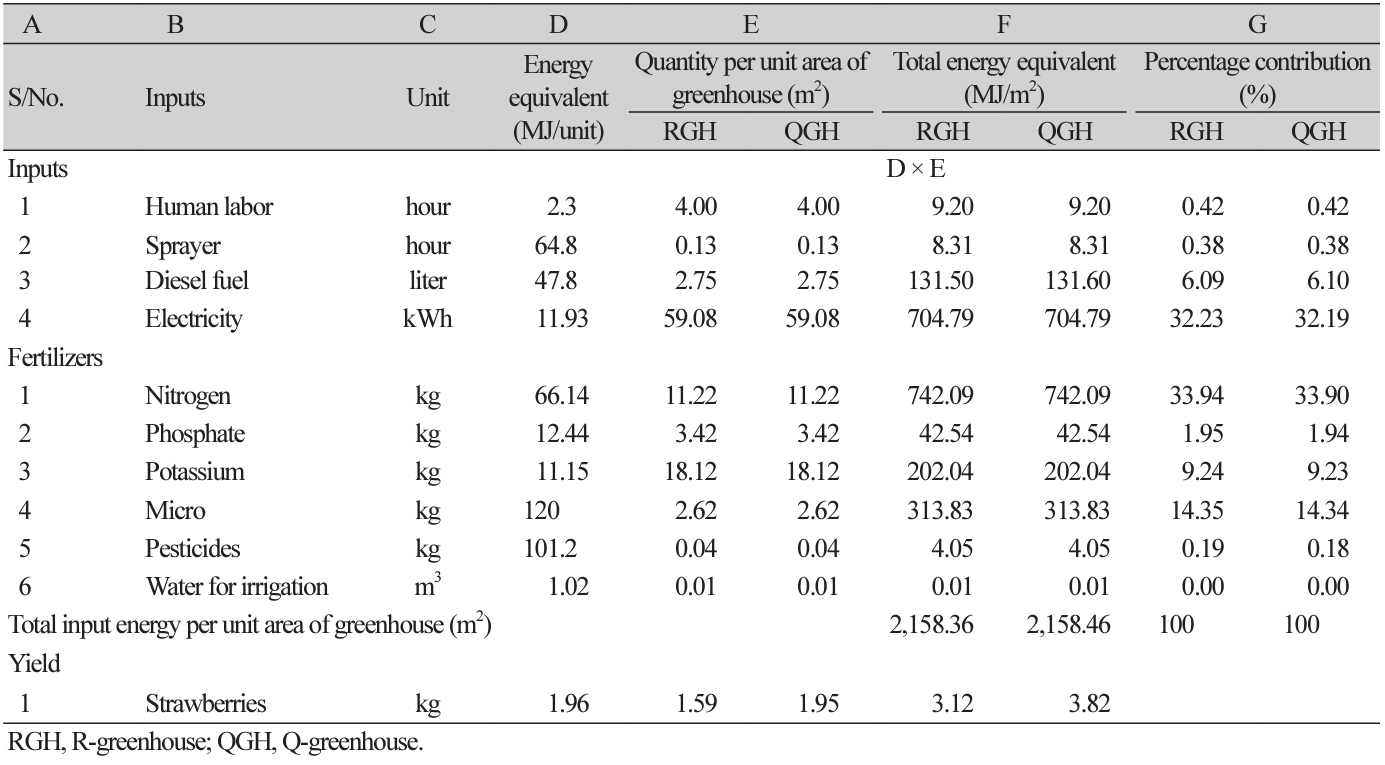Introduction
Agriculture both consumes and produces energy. As a subset of agriculture, greenhouse agriculture requires a great deal of energy for successful crop production within its contained microenvironment. The utilization of enclosed structures, such as glass or plastic-covered buildings, to produce a controlled environment for plant development is greenhouse technology (Akpenpuun and Mijinyawa, 2020). Greenhouses enable the year-round cultivation of crops, the protection of crops from extreme weather conditions, the expansion of production in regions with limited land, the maximization of water use, the minimization of chemical use, and the manipulation of light, temperature, and humidity to optimize plant growth (Shamshiri et al., 2018; Akpenpuun et al., 2022; Park et al., 2022). Greenhouses are an essential component of worldwide agricultural production and play an important role in plant research and breeding in addition to their benefits for food production (Mijinyawa and Osiade, 2011). Consequently, the importance of greenhouse crop production has increased as the global population continues to expand, the demand for food security becomes more urgent and as peoples’ lifestyle becomes more complex. Agriculture as a whole requires vast quantities of locally accessible noncommercial energies, such as seed, manure, and animate energies, as well as commercial energies directly or indirectly via fuel, energy, fertilizer, plant protection, chemicals, irrigation water, and machinery. Energy accounts for forty per cent of the overall cost of greenhouse crop growing (Rasheed et al., 2020). Utilizing these energies effectively increases output, productivity, and profitability (Banaeian et al., 2011).
Due to its high gross value of production and nutritious value, strawberry cultivation has attracted the attention of growers and researchers worldwide. Currently, the major producers of strawberries are the United States, Spain, Turkey, the Russian Federation, Japan, and the Republic of Korea. Strawberries may be cultivated in both open fields and greenhouses (Banaeian et al., 2012; Yoshida, 2013; Lee, 2014). In Korea, however, strawberries are exclusively grown in greenhouses and throughout the winter months, from October to April. Farmers have several advantages when winter strawberries are grown in enclosed buildings as opposed to in open fields. Gyeongsangnam-do, Chungcheongnam-do, Jeollanam-do, and Jeollabukdo are the largest strawberry-growing regions in Korea, accounting for 34, 32, 10, and 9% of the country’s total strawberry output, respectively. Maehyang, Akihime, Seolhyang, Santa, Seonhong, Daewang, and Flamengo are the primary strawberry cultivars farmed in Korea. However, Seolhyang accounts for about 85 per cent of South Korea’s entire strawberry production (Jeong et al., 2016; Lee et al., 2017).
Energy usage in agriculture is highly intense. Therefore, energy efficiency leads to enhanced output and the economic, competitiveness, and profitability of agricultural sustainability in rural areas. In this regard, energy inputs are required for lighting, heating, ventilation, irrigation, and fertilizer in greenhouse strawberry cultivation. Thus, agricultural yields and food availability are directly related to energy use (Banaeian et al., 2012).
Population expansion, limited arable land, and growing living standards have all contributed to a rise in agricultural energy use. In agriculture, this has led to the creation of energy sources and usage and conservation measures. In this regard, several experts have examined and reported on the energy use of numerous crops. In the energy and economic analysis of strawberry production in Teran, for instance, researchers analyzed the energy efficiency and energy usage pattern (Banaeian et al., 2011), the prediction of greenhouse tomato yield (Belouz et al., 2022), typical village operations in India (Singh et al., 2003), the energy efficiencies or inefficiencies for strawberry production in Iran (Banaeian et al., 2012), the optimization of energy inputs for wheat crop in Punjab (Singh et al., 2004), and the energy-use patterns of some field crops and vegetable and cotton production in Turkey (Canakci et al., 2005; Yilmaz et al., 2005) and maize and sorghum in the United States (Franzluebbers and Francis, 1995). Meanwhile, Hatirli et al. (2006) determined energy inputs and yield relations for greenhouse tomato production, whereas Canakci and Akinci (2006) and Ozkan et al. (2004b) determined energy use for tomatoes, cucumbers, eggplants, and peppers cultivated in greenhouses in Turkey.
Greenhouse production is one of the most energy-intensive and labor-intensive plant production techniques. In this regard, energy budget is crucial. The energy budget is the quantitative evaluation of the input-output relationship of a system in terms of energy units (Canakci and Akinci, 2006; Kim et al., 2019). In greenhouse production, considerable operational expenses are incurred by producers. Consequently, it is crucial to define all energy inputs in greenhouse production in order to determine their ideal combination for more energy-efficient production.
Thermal curtains, also known as energy curtains or thermal screens, are commonly used in greenhouses to manage temperature, energy efficiency, light management and crop protection Thermal curtains are made from specialized materials with high insulating capacity and are available in various colors and textures, their primary function is to regulate temperature rather than provide aesthetic appeal (Rabiu et al., 2022). They are used in the temperate regions to reduce the heating demand and improve energy retention inside the greenhouse, while in the warmer regions, thermal curtains are used primarily to reduce the cooling demand and prevent heat stress (Akpenpuun et al., 2023). The energy-saving efficiency of the thermal curtain is dependent on the types of screens and position of its installation (de Zwart, 1996). Zakir et al. (2022) investigated the position of thermal curtain in single-span greenhouses are concluded that the position of the curtains had a certain level of impact on the microclimate of the greenhouses and ultimately on the yield. In a similar context, Akpenpuun et al. (2021) investigated the configuration of the glazing material and thermal curtain and reported that covering material and thermal curtain had effect on the heating demand of single- and double- layered single-span greenhouses.
Land productivity is a measure of the total output per unit of land used in production (Pingali and Smale, 2001; Banaeian et al., 2011). The amount of crop produced per unit area (kg/ha), known as yield, is most often referred to as the total measure of productivity. This concept of productivity is only partial as it does not include labor, fertilizer, irrigation, and energy (fuel or electricity) productivity (Banaeian et al., 2012). Similarly, the energy-use efficiency (the ratio of output energy to input energy) and specific energy (the ratio of input energy to yield [MJ/kg]) of farmers in crop production systems are indices that can characterize the efficiency and performance of farms (Ozkan et al., 2004a; Ozkan et al., 2004b; Tabatabaie et al., 2013; Bolandnazar et al., 2014).
The most frequently used energy sources include electricity, natural gas, and diesel (blended or unblended). The energy equivalents of inputs and outputs in greenhouse strawberry production are determined using the concept of energy balance, which is the difference between the total energy inputs required for successful production and the total energy contained in the yield. The demand for energy in agricultural operations is twofold: direct energy demand (DED) and indirect energy demand (IDED). IDED includes energy utilized in farm operations, such as fertilization, chemical applications, and machinery use (e.g., sprayers), whereas DED includes human labor, diesel fuel, water for irrigation, and electricity (Mohammadi and Omid, 2010; Banaeian et al., 2011). Fig. 1 shows farm inputs, production operations, and harvest and postharvest processes.
The main objective of this paper was to determine the energy use ratio, energy productivity, and specific energy of two single-span gothic greenhouses with different thermal curtain positions used for strawberry production and compare their input-output energy use.
Materials and Methods
The materials and methodology adopted in this present research is the same as that previously reported by Akpenpuun et al. (2021) who investigated energy consumption in the experimental greenhouses by virtue of the configuration of the covering material and Zakir et al. (2022) who compared the effect of the thermal curtain positions on the microclimate and strawberry productivity. This present investigation is an extension of these previously published papers. The experiments were conducted between December 2021 to April 2022 in season one and repeated in December 2022 to April 2023 in season two. Fig. 2, 3 and 4 show the sensor locations, air circulating fans and boiler positions, and thermal-curtain positions, respectively. In the RGH the thermal curtain was positioned directly at the roof ridge of the greenhouse, while in the QGH the thermal curtain position as at 5o from an imaginary vertical line through the roof ridge to the north side of the greenhouse.
Energy analysis
Tables 1 and 2 show the inputs and output energy equivalents of the activities and processes involved in the production of strawberries and the management activities, periods, and specifications for the experiments. The criteria for selecting the inputs in this analysis was based on inputs that have direct influence on the energy consumption of a greenhouse cropping systems. Also, to ensure consistency in the energy units used throughout the analysis, only the literature with common energy unit and the best available conversion factors were referenced. The selected inputs in this energy analysis are considered to have significant impact on energy consumption, the most directly related to greenhouse cropping activities and have substantial contribution to overall energy use.
Based on energy equivalents, the energy use ratio, energy productivity, specific energy and net energy were calculated using equations 1 to 4 (Banaeian et al., 2011; Belouz et al., 2022):
Results and Discussion
Analysis of input–output energy use in strawberry production in single-span greenhouses
Tables 3 and 4 show the inputs and output energy analysis of the two single-span greenhouses (RGH and QGH) in the 2021/2022 cand 2022/2023 cropping season used in this study and the energy equivalents of the inputs and output operations. The results revealed that the working hours of labor, fans, sprayers, and fertigation durations were 468, 4,320, 15, and 648,000 h per greenhouse, respectively, in the two seasons experiments. The total volumes of diesel consumed by the boilers the first and second season was 390.70 L and 321.87 L, respectively, in the RGH and 397.50 L and 322.12 L, respectively, in the first and second season in the QGH. The respective mean volumes of diesel consumed was 3.1 ± 2.6 liter and 3.79 ± 3.13 liter respectively, in the RGH and 3.2 ± 2.8 liter and 3.85 ± 3.24 liter, respectively, in the QGH.
The total energy used for all inputs, fertilizers, pesticides, and water for irrigation in the RGH and QGH were the same in both seasons (2021/2022 and 2022/2023) because the greenhouse had the same operating parameters and inputs. The total energies were 2,186.48 MJ/m2 and 2,189.26 MJ/m2, respectively, in the RGH and QGH whose floor area was 117 m2 as compared to the total energy of 805,376.3 MJ/m2 (805,376.3 MJ/ha) for a greenhouse size of 2,700 m2 (0.27 ha), reported by Banaeian et al. (2011), who investigated the energy-cost benefit analysis of greenhouse strawberry production in Tehran which has similar climate as Daegu, the experimental site for this experiment. Canakci et al. (2005) recorded energy inputs of 17,629.5, 14,348.9, and 3,735.4 MJ/ha after appraising open-field energy use pattern for tomato, cotton crop, and wheat, respectively, in the Antalya region of Turkey. The results presented in Table 3 also show that electricity contributed 32.23 and 32.19% of the total amount of energy consumed to the RGH and QGH, respectively. Nitrogen contributed high input energies of 33.94 and 33.90% for the RGH and QGH, respectively. Meanwhile, Hatirli et al. (2006) estimated that diesel, fertilizers, electricity, and chemicals contributed 34.35, 27.59, 16.01, and 10.17%, respectively, to the total amount of energy consumed when they examined energy-use patterns and the relation between energy inputs and energy output for greenhouse tomato production in the Antalya province in Turkey. The energy input from pesticides and water for fertigation was quite low compared with other inputs in the greenhouse strawberry production. This is similar to the findings of Ozkan et al. (2004b), who also examined the energy equivalents of inputs and outputs in greenhouse tomato, eggplant, cucumber, and pepper productions in the Antalya province of Turkey.
The net energy determined for RGH and QGH were -2,152.32 MJ/m2 and -2,152.18 MJ/m2 in the first season, respectively, and -2,182.08 MJ/m2 and -2,184.38 MJ/m2 in the second season, respectively. Comparing these values with the value of -683,488.37 MJ/ha obtained by Banaeian et al. (2011), the net energy obtained in this research were similar even though the greenhouses used in this study were only 4.33% of the size of their greenhouse. The negative value for the net energy shows an energy loss in the greenhouses and can be attributed to the low-level technology of ventilation, high electricity consumption by air-circulation fans, high diesel-fuel consumption by the boiler during heating, and dependence of the venting and heating systems on a single-point temperature controller. However, there was no significant difference between the energy use between the RGH and QGH even though the thermal curtain position was different.
Energy productivity is a measure of how efficiently the boiler energy was used to produce 1 kg of strawberries in the greenhouse during winter. The energy productivities in the RGH and QGH was 0.001 and 0.001 kg/MJ in all the seasons compared with the energy productivity of 1.53 kg/MJ for sugar beet (Erdal et al., 2007) and 0.09 kg/MJ for greenhouse tomatoes (Hatirli et al., 2006). Meanwhile, the energy-use efficiency for greenhouse strawberries in Tehran province was determined to be 0.15 by Banaeian et al. (2011), while Canakci and Akinci (2006) reported that the energy-use efficiencies of greenhouse tomato, pepper, cucumber, and eggplant were 0.32, 0.19, 0.31, and 0.23, respectively, after examining the energy use pattern of common greenhouse vegetables in Antalya. The values of the energy ratio for RGH and QGH were consistent with findings reported by other authors, although the greenhouses used in this research were 58% smaller. The energy productivities in both greenhouses were the same, meaning that the same output of strawberry fruits can be produced per unit of energy input. This translates to the same energy costs and environmental impacts.
The RGH and QGH specific energy in the first season was 1,354.40 MJ/kg and 1,108.21 MJ/kg, respectively, whereas in the second season, the specific energy expended by the RGH and QGH was 974.36 MJ/kg and 880.55 MJ/kg, respectively. These values are way higher than the specific energy values of 5.24, 11.24, 3.88, 16.21, 1.14, 0.98, and 0.97 MJ/kg for wheat, cotton, maize, second crop sesame, tomato, melon, and watermelon crops, respectively, reported by Canakci et al. (2005). This wide gap can be attributed to the fact that the Canakci et al. (2005) experiment was in the open-field. However, Banaeian et al. (2011) reported 12.55 MJ/ha for strawberries in Teran province, while Hatirli et al. (2006) recorded 12,380.3 MJ/t for greenhouse tomato production in the Antalya province of Turkey for a 1,000 m2 floor area greenhouse. The use of nitrogenrich fertilizers and micronutrient fertigation solutions increase the total energy requirements as low energy output, in terms of yield, decreases the energy ratio. This measure is useful for comparing the energy efficiency of different crop production systems. This is the amount of energy required to produce 1 kg of strawberries. This result shows that in the winter, the RGH required a higher amount of energy to produce a kilogram of strawberries than that of QGH. Consequently, the QGH is economically preferable as it requires less diesel fuel to generate heat energy.
The values of the energy ratio recorded for RGH and QGH was 691.02 and 565.42, respectively in the RGH and QGH in the first season experiment, while in the second season the energy ratio estimated was 497.12 and 449.26, respectively, for RGH and QGH. Hatirli et al. (2006) recorded a 1.2 output-input energy ratio for a 1,000 m2 greenhouse for tomato production in the Antalya province of Turkey, while Kizilaslan (2009) reported 0.96 for greenhouse cherries over an area of 10,000 m2. Whereas, Canakci and Akinci (2006) reported energy ratio values of 2.8, 4.8, 3.8, 1.5, 0.7, 1.9, and 2.0 for fieldcultivated wheat, cotton, maize, second crop sesame, tomato, melon, and watermelon crops, respectively, while Yilmaz et al. (2005) recorded an energy-use efficiency of 0.74 for an average cotton farm size of 1,000 m2 in Turkey. The QGH had a lower energy ratio in the two compared seasons, which is desirable. This can be attributed to the position of the thermal curtain, as already reported in Zakir et al. (2022), which allowed more solar radiation into the greenhouse environment.
Conclusion
The following conclusions can be drawn from this investigation:
1. Greenhouse strawberry production in the two seasons of reference consumed a total of 2,155.23 and 2,154.64 MJ/m2 (season one) and 2,186.48 and 2,189.26 MJ/m2 (season two) in the RGH and QGH, respectively, in terms of human labor, sprayers, diesel-fuel consumption, electricity, fertilizers, chemicals, and water for irrigation. The highest percentages of energy expended in both experiments was contributed by electricity and nitrogen fertilizers as an inputs with an average contribution of 32 and 34% in both greenhouses.
2. The energy outputs from the RGH and QGH was 3.12 and 3.82 MJ/m2, respectively, in season one and 4.40 and 4.87 MJ/m2, respectively, from the RGH and QGH in season two.
3. The energy productivity, specific energy, and net energy of strawberry production in the single-span greenhouses of 117 m2 floor area was 0.001, 1,354.40 MJ/kg, and -2,155.23 MJ/m2, respectively, for RGH and 0.001, 1,108.21 MJ/kg, and -2,154.64 MJ/m2 for QGH during season one experiment.
4. The energy productivity, specific energy, and net energy of strawberry production in the single-span greenhouses of 117 m2 floor area was 0.001, 974.36 MJ/kg, and -2,182.08 MJ/m2, respectively, for RGH and 0.001, 880.55 MJ/kg, and -2,184.38 MJ/m2 for QGH during season two experiment.
5. There was no significant difference between the energy use between the RGH and QGH even though the thermal curtain position was different.
6. There was no substantial difference between the energy use between season one and two.
Acknowledgements
This work was supported by the Korea Institute of Planning and Evaluation for Technology in Food, Agriculture and Forestry (IPET) through Agriculture, Food and Rural Affairs Convergence Technologies Program for Educating Creative Global Leader, funded by Ministry of Agriculture, Food and Rural Affairs (MAFRA) (717001-7). This research was supported by Basic Science Research Program through the National Research Foundation of Korea (NRF), funded by the Ministry of Education [NRF-2019R1I1A3A01051739].
Authors Information
Timothy Denen Akpenpuun, https://orcid.org/0000-0002-3211-3005
Wook-Ho Na, https://orcid.org/0000-0001-8698-9734
Qazeem Opeyemi Ogunlowo, https://orcid.org/0000-0001-6595-8162
Misbaudeen Aderemi Adesanya, https://orcid.org/0000-0002-7335-4112
Prabhat Dutta, https://orcid.org/0000-0001-5997-7121
Ezatullah Zakir, https://orcid.org/0000-0002-4585-6799
Hyeon-Tae Kim, https://orcid.org/0000-0003-0788-1536
Hyun-Woo Lee, https://orcid.org/0000-0001-8557-2099



